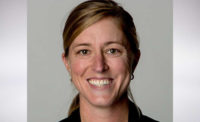Name: Michelle Fennell
Age: 32
Title: Associate, HVAC, BR+A Consulting Engineers
Educational Experience: B.S. in architecture from Wentworth Institute of Technology and is currently working on an associate of mechanical engineering technology from University of Massachusetts Lowell.
Professional Credentials/Accreditations: LEED AP BD+C
Organizational Affiliations/Achievements/Awards: ASHRAE member, International Institute for Sustainable Laboratories (I2SL) England founding member and former young associate chair, and I2SL benchmarking working group member.
When did you fall in love with engineering?
I have always enjoyed math and figuring out how things fit together. In high school, my guidance counselor recommended trying some technical drawing courses instead of the accounting I was looking at, and I am forever grateful for that recommendation. My high school technical drawing teacher, Mr. Faust, not only taught us how to draw machine parts but took the time to explain real-life engineering problems and solutions. After four years and almost a dozen different drafting courses, both hand- and computer-based, there was no turning me off the track I’d started down.
What has been the most rewarding aspect of working in the skilled trades?
Seeing the construction and operation of things that you created on paper has been very powerful and rewarding. It’s one thing to draw lines on paper, but it’s very different to see things come to life in a real building. The number of people who are involved in the process is overwhelming, and I’ve had the opportunity to meet and work with many great people on the construction side.
What challenges do women face in this profession? Why aren’t there more women in engineering?
Being a woman in engineering brings a number of challenges and opportunities. I often find myself in a male-dominated room or project team where I feel the need to prove my knowledge. Having this experience over the past 10-plus years, I have realized that being a woman is also an opportunity to provide a different view. Women and men need to work together to help find resolutions for some of the challenges in the industry, including unconscious biases, first impressions, motherhood expectations, and a lack of role models who look like them. All young engineers face challenges when it comes to first impressions. When you walk into a meeting or onto a job site and meet people for the first time, there is an immediate expectation made of you that can be hard to overcome. You need to prove yourself so that when you come back, people don’t question if you know what you’re talking about. It has always seemed to me that young men are given the benefit of the doubt, assuming they know what they are talking about until proven otherwise, while young women need to prove they know what they are talking about to be taken seriously. Unconscious biases play into both first impressions and motherhood expectations. Some women I know have had trouble being taken seriously by senior men once they either become pregnant or have children. If women don’t feel like they’re being taken seriously, they will look to invest their talents elsewhere. Men may misunderstand this as women wanting to step back from work, when oftentimes they’re trying to step into work instead. Some women do want to step back or move to jobs that allow more flexibility, which causes some women to leave the engineering side as well. When you look at senior management in many engineering companies, there are few women. The number has been increasing, but it’s not rising fast enough. Women who look to the leadership of their company and try to figure out where they fit in may not realize they can fit in with leadership over time.
The number of women in engineering has been slowly increasing, but it could still be better. Targeting younger girls so they can see that engineering is interesting and something they should consider is the first part of getting more women in engineering. The second part is keeping them. Allowing flexibility, flex time, or occasional work-from-home options would go a long way for all parents to feel they are capable of having both a career and family. Flexible policies are not just good for women; they’re good for everyone. Creating workplaces that take women seriously, regardless of their age or whether they have children, would help women to feel that they can stay at their employers.
Describe what your job entails on a day-to-day basis.
My job includes a variety of different tasks, which help to keep every day interesting and challenging. For a new building, I get the opportunity to help design the various building systems, air, cooling, and heating from beginning to end. I create floor plans, flow diagrams, specifications, and control diagrams to work through the details of each project and work directly with owners and architects to coordinate the special needs of each building or renovation. I visit job sites and work with the construction team and contractors to solve problems as they arise during the construction process and work with junior employees teaching them how the pieces of the project fit together.
Within my company I lead the HVAC BIM committee, which creates standards for how we work with Revit. I’m also part of our sustainability committee, which works to keep highly efficient and sustainable solutions part of our everyday mindset. I’m involved in project pursuits and interviews for new projects and am one of the energy code experts in my office, often answering questions for people of all trades on what is required for a project.
What drives/motivates you every day?
I’m one of those rare people who loves her job. I honestly enjoy going to work every day. I’ve had the opportunity to work on some amazing projects. Hospitals, lab buildings, and vivaria are anything but boring. These are challenging settings, each with their own different specialty equipment, codes, and standards that need to be followed. I have the opportunity to keep learning with everything that I do. Learning and problem solving keep me constantly interested in my work.
Describe the proudest moment in your career.
There are many moments I’ve been proud of in my career. One of them involved a new project pursuit. We were chasing a new inpatient hospital project, what would be the largest project my company has ever worked on, and I was picked to be part of the pursuit and interview team. My role as both an HVAC engineer and sustainability coordinator fit well into the proposed project team. I was able to work closely with many senior members of my company I don’t typically interact directly with. After several weeks with the team developing a strategy, creating the presentation, and countless run-throughs, 10 of us traveled for the interview, where I had a large speaking role. We were ultimately awarded the project, which was a great achievement for me personally as well as for my company as a whole.
I am also incredibly proud of presentations I’ve given over the last few years. I have presented at I2SL annual conference several times. I’ve also presented before the Massachusetts Hospital Association alongside the president of my company and the heads of two Boston-area hospitals. I’ve also given a handful of in-house presentations at my company. If you would have told me when I was in high school or college that I would be giving large presentations and enjoying it, I never would have believed it. I now look forward to these presentations as an opportunity to teach others the things I have learned.
What remains on your engineering bucket list — what do you aspire to do that you haven’t done yet?
I’ve been very fortunate to work on very large and complicated projects in the 10 years I’ve been with my company. One thing I would love to do is see a net-zero or net-positive project through to the end. I’ve recently found myself with this opportunity in design and look forward to following the project through to see the end result when the building is operating. With the amount of energy used by the building industry as a whole, it’s important to always consider the energy use of a building during the design process when making major decisions. Designing a project that not only prioritizes energy reduction but eliminates energy use over the course of a year would be a great achievement for me personally. I look forward to continuing to help owners to understand the feasibility of net-zero buildings as the industry works to reduce the impact of new buildings on climate change.
What’s one thing no one knows about you?
Not a lot of people outside of close friends and family know about my love of photography. I have a fairly nice camera and have been known to walk for hours just wandering around taking pictures. It started when I received my first camera in elementary school. Now I have a hard time seeing a beautiful landscape, sunrise, or attending any sort of family event without taking tens if not hundreds of pictures. I live through my camera and have many amazing memories captures on film to relive whenever I like.
List any mentors who’ve helped you succeed and describe exactly how they’ve shaped your success.
I’m fortunate that I have had a lot of support in my career. While at the beginning I felt like there were people I needed to prove myself to, once I was able to demonstrate that I can do the work I garnered their full support. One person who has had a big influence on my career is Patrick Duffy, who is now a principal at BR+A. The last few years, Pat has helped push me to take on more, helped provide me with opportunities both internally and externally, and helped me to understand the importance of our jobs outside of being a good engineer such as creating lasting relationships with the people we work with both inside and outside the company. After 10 years in the same company, I have amassed many advocates and cannot thank them enough for everything they have all done for me.
What does the future hold for you?
I’d like to think that I am just beginning. I will continue to do things that bring me joy and challenge me as a person. Continuing to take on new projects, looking for opportunities to learn, and more importantly finding opportunities to share what I have already learned both internally at my company and externally at conferences. I feel at home in my current company and look forward to becoming part of the senior leadership over time.
What advice do you have for prospective female engineers considering entering the field?
My advice to female engineers is to work hard and show you both can and want to do the work. If you’re willing to do the work, there is no ceiling to what you can achieve. Don’t worry about what may get you into the room or a seat at the table. What matters is what you do once you’re there. Take the opportunities that come your way. You do not have to accept the status quo. Things don’t necessarily move fast in this industry, but things are changing for the better. If you want to change something in your company, do some research on what other companies have that your company could work on. Put the facts together and show the leadership. There is a need for female leadership within the industry, and you can be that leadership.




